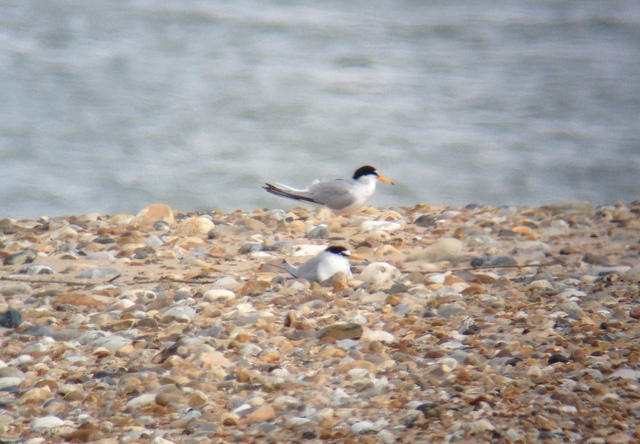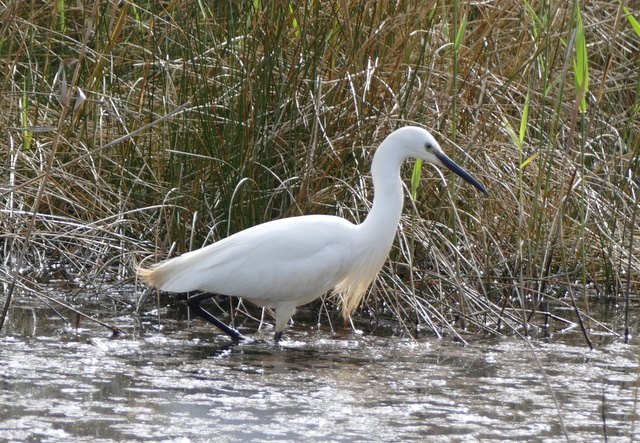Day 2 of a long weekend of tours today. What a difference a day makes! It was sunny with patchy cloud all day, although a blustery west wind in the morning took the edge of the temperature.
We started with a drive through farmland inland. We hadn’t gone far when a Little Owl hopped up onto the roof of a barn next to the road. Unfortunately, by the time we reversed back, it had disappeared. A likely looking roadside field produced a Stone Curlew distantly amongst the flowers in the margin. Great to see these birds doing so well in North Norfolk now.
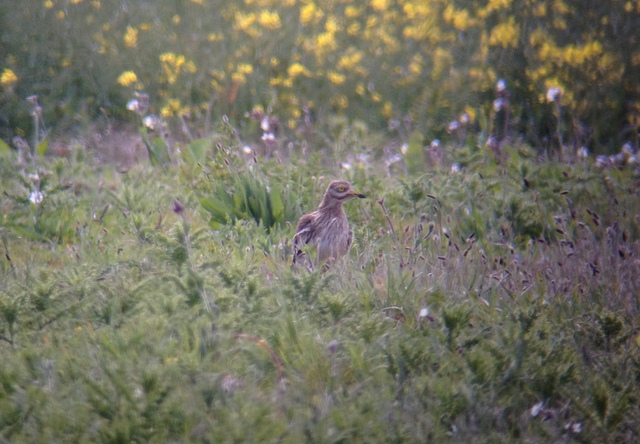 Stone Curlew – in amongst the flowers
Stone Curlew – in amongst the flowers
As we explored inland, there were lots of Skylarks singing overhead. Little groups of Linnet appeared from the weedy margins. A nice male Grey Partridge called nearby before walking quietly into the hedge and we got a good look at another pair, particularly the male’s orange face and blackish belly patch. We had a scan for raptors as well this morning, but there were only a few Common Buzzards circling up in the cool windy conditions.
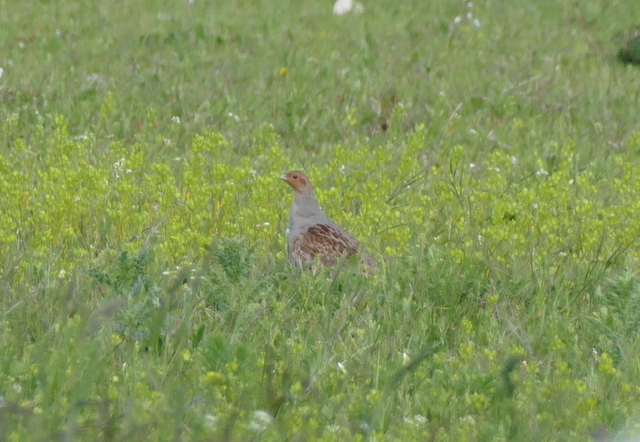 Grey Partridge – calling from a field by the road this morning
Grey Partridge – calling from a field by the road this morning
We meandered round to Burnham Overy and eventually found ourselves at the start of the track out to the dunes. There were a couple of Common Whitethroats singing from the hedges either side. Down at the bottom, they were replaced by several Lesser Whitethroats. We could hear one calling and see it flicking along the hedge. There were at least two singing, and a an adult feeding unseen young nearby. On the way out to the seawall, we also saw – and heard – a number of Sedge Warblers singing from the edges of the ditches.
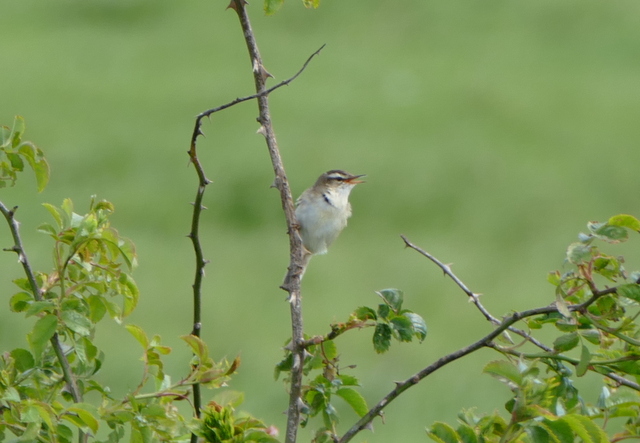 Sedge Warbler – singing by the side of the track out to the seawall
Sedge Warbler – singing by the side of the track out to the seawall
By a gap in the hedge, we stopped to scan the grazing marshes. A Common Buzzard was circling up nearby and as we looked at it we could see a Marsh Harrier nearby. At the same time, a Red Kite appeared above the wood beyond. Three species of large raptor in view at the same time – not bad.
There were also several butterflies along the track this morning. There seem to be a lot of Wall butterflies out at the moment. But the highlight was a lovely Green Hairstreak which landed in the vegetation beside the path. We stopped to admire its sparkling metallic green underwing.
 Green Hairstreak – with its metallic green underwing
Green Hairstreak – with its metallic green underwing
From up on the seawall, the first bird we saw was a Fulmar flying towards us over the path, a bit of a surprise. This is not the most likely bird to see here, away from their more normal habitat over the sea, although they do occasionally wander a little way inland, often at this time of year. It circled out over the grazing marsh. A pair of Mediterranean Gulls was more predictable these days. They flew in over the reedbed and away west, flashing their translucent white wingtips as they came overhead. They were with a single Black-headed Gull which gave a great flight comparison for us between the two species.
Scanning the reedbed pool, there were several large white birds but at first there only seemed to be Mute Swans. Then, as if by magic, a Spoonbill appeared (it had probably been tucked into one of the corners out of view, close in along the reed edge. It proceeded to work its way along the back edge of the pool, sweeping its bill from side to side. We got a great look at it in the scope.
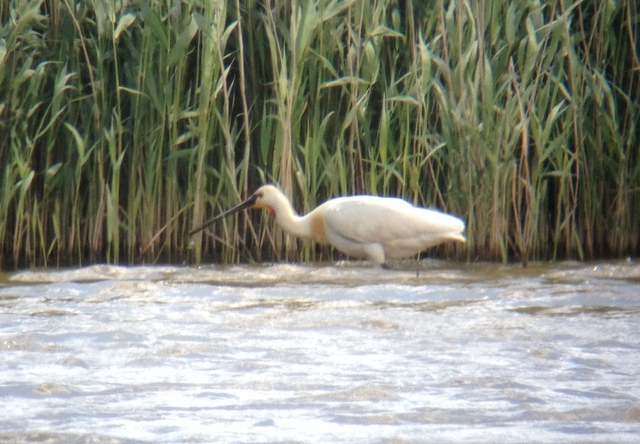 Spoonbill – the first of many today, feeding on the reedbed pool
Spoonbill – the first of many today, feeding on the reedbed pool
We really didn’t know which way to look here, there was so much to see. There were lots of Swifts swooping low in the wind, over the grazing marshes and reedbed and along the banks of the seawall, zooming past us at high speed. A pair of Little Terns landed on the mud out on the saltmarsh – one of them seemed to spend much of the morning feeding over the channels in the grazing marsh, returning occasionally to its mate. Bearded Tits called from the reedbed and a single bird flew up and away from us before dropping back into the reeds out of the wind. We could also hear Reed Buntings and Reed Warblers singing.
Then came one of the many highlights of the morning. A Hobby appeared flying towards us. It hung in the air for a second, just before it got to the seawall, then turned and powered away along the near edge of the reeds. It had obviously seen something and soon we could see what it was after. Out over the grazing marsh the Hobby engaged in an aerial duel with a House Martin, the latter just twisting and turning out of the Hobby’s reach, relying on its superior manoeuvrability to get it out of trouble. The Hobby pursued it for some time, swooping at it repeatedly before it finally gave up.
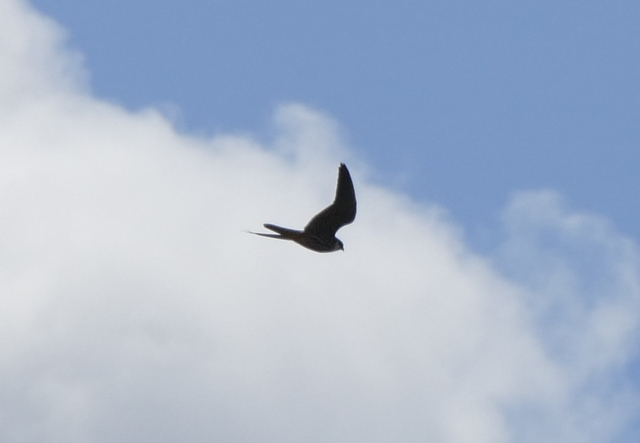 Hobby – just about to chase off after a House Martin
Hobby – just about to chase off after a House Martin
Eventually we managed to tear ourselves away and walked on towards the dunes. Someone we passed on the way reported having seen a shrike earlier in the morning, on the edge of the dunes to the east. It seemed worth looking for, so we set off towards the pines. There were several more butterflies in the more sheltered parts of the dunes – Brown Argus, Common Blue and Small Copper. And ever more Southern Marsh Orchids coming into flower now.
We couldn’t find the shrike, but we did find a very nice little group of Greenland Wheatears in the dunes. At first we came across a female. When she disappeared behind a dune, a male emerged from the other side. As we walked round into the dunes the way they had gone, we found yet more males, at least three together. Smart birds – we got a male in the scope and admired its characteristic orange-toned throat and upper breast.
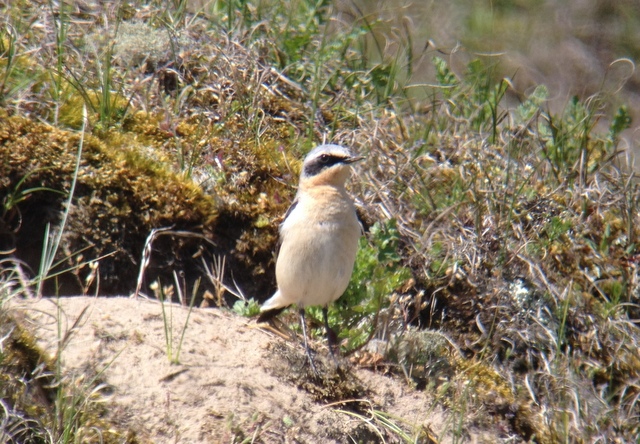 Greenland Wheatear – one of several smart males in the dunes again today
Greenland Wheatear – one of several smart males in the dunes again today
By this stage, it was getting on towards lunchtime, so we had to head back. On the way, we found yet more Wheatears. There were now two Spoonbills together on the reedbed pool. And, as we walked back across the grazing marsh, a third Spoonbill flew across just in front of us – unfortunately, we did not have cameras at the ready. It landed out by one of the small pools in the grass and started to feed.
After lunch by the harbour at Burnham Overy, we drove back to Wells. The beach car park was extremely busy – probably not a great surprise on a sunny Saturday of half term – but we managed to find a space. The gull colony was equally busy. Several of the pairs of Black-headed Gull have chicks now, but the Mediterranean Gulls seem to be a bit behind. We could just see several sitting birds amongst the marram grass, flashing the black heads and brighter red bills. A pair of Common Gulls have chosen to nest right at the top of the beach, below the other gulls, and we admired them through the scope.
The Common Terns were not as active in the middle of the day, but we could see several birds sitting on the stones. Looking carefully through them, we picked out a single Arctic Tern. It was great to see the two species close together – we could see the Arctic Tern’s shorter, darker blood-red bill lacking a black tip, and its longer tail streamers. There were also lots of Little Terns on the beach below, much more active than the others, they would periodically get up and fly round, fishing in the channels.
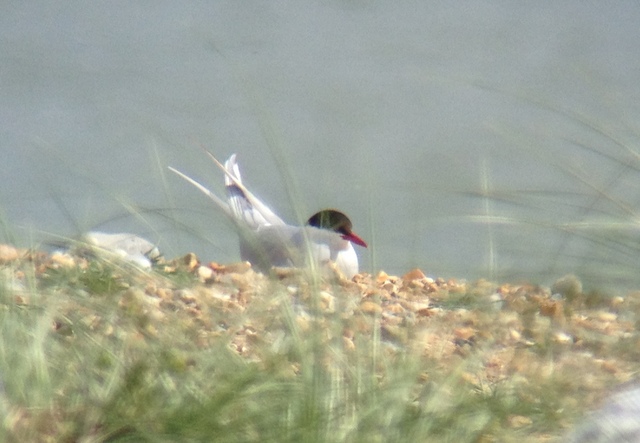 Arctic Tern – great to see alongside Common Terns today
Arctic Tern – great to see alongside Common Terns today
A quick look out in Wells Harbour produced a better selection of waders than of late. As well as the regular horde of Oystercatchers, there was a nice flock of smaller waders on the stony islands – although they were quickly moved off by the rising tide. They were mostly Ringed Plovers, at least 20 of them. A look through the scope also revealed about five Turnstone, several black-bellied Dunlin in summer plumage and a couple of white-bellied Sanderling, a greyer bird still mostly in winter plumage and a chestnut-coloured bird in summer garb.
We wanted to do one more thing before we finished, so we headed round to Lady Anne’s Drive and walked west on the inland side of the pines. The wind had dropped a little and with the shelter of the pines it was warm this afternoon. Consequently, the activity of the warblers and tits was down on recent weeks. By Meals House, we finally heard a Cetti’s Warbler and while looking to see if we could see it, we found a nice pair of Blackcap gathering food.
We could hear a couple of groups of Long-tailed Tits and a few Goldcrests, though they were hard to see in the trees today. But we did find a family of Treecreepers. We could hear quiet calls from the trees and found one of the adults first, climbing up a pine. When it flew across the path, we realised there were several hiding in the bushes and we could see several short-tailed juveniles practising climbing up tree trunks in between pestering the adults for food.
 Spoonbill – adult and juveniles on the nursery pool
Spoonbill – adult and juveniles on the nursery pool
From the Joe Jordan hide, we could immediately see several Spoonbills down on the pool below the trees. As we had seen earlier in the week, there were both adults and several smaller, whiter, shorter-billed juveniles – ‘Teaspoonbills‘. Already taking after the adults, they seemed to spend quite a bit of time sleeping! However, it was great to watch them when they woke up – already trying to feed in the shallow water and then chasing after their parents, bouncing up and down and begging, when they got hungry.
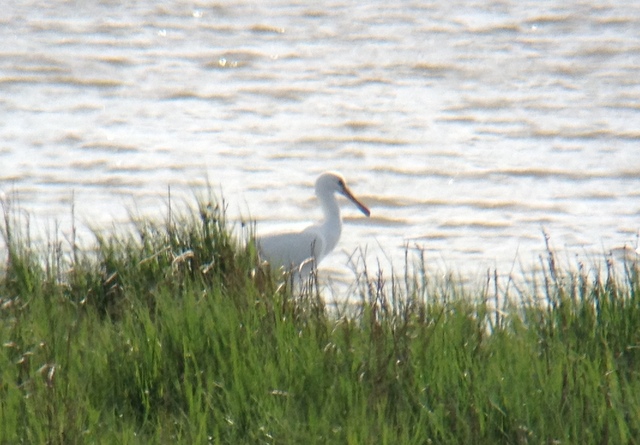 Spoonbill – a short-billed juvenile or ‘Teaspoonbill’
Spoonbill – a short-billed juvenile or ‘Teaspoonbill’
There were lots of other birds to see here as well this afternoon, as usual. Marsh Harriers out over the grass, Avocets and ducks on the pools, and a large flock of Black-tailed Godwits whirling round. The usual pair of Grey Partridge were feeding on the short grass below the hide.
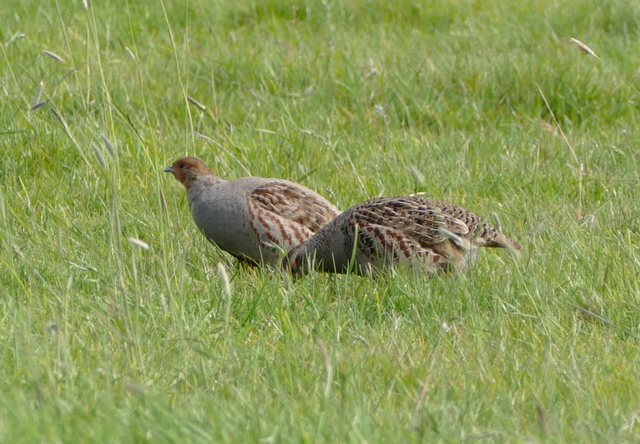 Grey Partridge – the usual pair at the Joe Jordan hide
Grey Partridge – the usual pair at the Joe Jordan hide
Unfortunately, once again we had to drag ourselves away. We walked back to the car, stopping briefly to admire a Little Egret feeding in the reeds by Salts Hole on the way. What a great day it had been.
